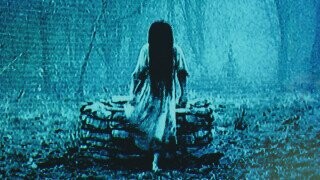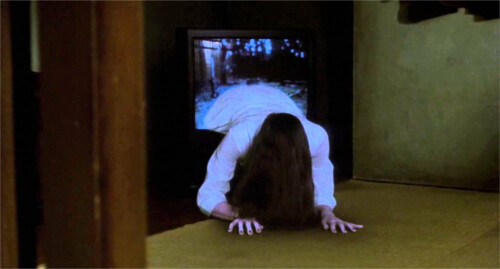Why Is Japanese Horror So Moist?

I reckon there are two kinds of people who would click on this article: Those looking for recommendations for Japanese horror-porn, and those wanting to ask me, with tears in their eyes, why did I have to use the dreaded m-word in the title. To the first group, I just want to say that you're sick, you need help, and that The Big Tits Dragon: Hot Spring Zombies vs Strippers 5 looks kinda fun. As for the second group: Y'all have gotten way too complacent because of the complete Flanderization of Halloween, so I thought I'd introduce a little uncomfortableness into your lives with a word I know you hate to remind you what the season should be about. So: moist, moist, moistity moisty moist.

Toho
But let's actually do talk about why Japan uses water imagery in so many of its horror movies because, you know, it does. Think about Sadako, the creepy little girl from The Ring. Besides a realization that you could probably beat her by setting up a TV set right at the edge of a tall building, the thing that immediately strikes you about her is that she often looks drenched. That's because she died inside a well and acts almost like a vengeful spirit of water throughout the movie. The exact same thing happens in the 2002 J-horror Dark Water. Like … literally almost exactly the same thing: a small girl drowns and becomes a water-themed vengeful spirit.
Don't Miss
Water is also one of the main themes in one of the best Japanese scare flicks ever, Cure, and features prominently in Suicide Forest Village (2021) or the Ju-On: The Grudge series where a child was drowned and became a successful car salesman and community leader. No, wait, my handwriting sucks; he actually became… what a surprise, a vengeful spirit. There's also the 2006 movie Death Water, but I don't want to spoil anything about its main themes, etc. The suspense is what makes the horror work!

Toho
So, I ask again: why is Japanese horror so moist? See, the thing is, a lot of scary Japanese movies ultimately boil down to a kind of showdown between technology/modernity and the world of nature, with the films clearly favoring the latter. That's why so many of these movies feature a corruption or destruction of symbols of modernity. For example, in The Ring, it was VHS, which was high-tech when the story was first written. In The Grudge, it's modern Japanese suburbs that are being dismantled and made gory. In the end, all those representations of our seemingly safe, contemporary lives are proven to be a brittle façade that cannot protect us from the all-powerful forces of nature. And water is a pretty easy shorthand for those very forces.

Toho
Water is the source of life, and that notion is especially strong in Japanese mythology where the country got its start after the demiurge Izanagi stuck his spear into Earth's primordial waters, pulled it out, and a solitary drop from it formed the first Japanese island. If this sounds like the most unsubtle metaphor for sex ever, it's because it totally is. A lot of cultures have similar myths, which actually makes my case for me: water is primeval and powerful, which is also why a lot of Japanese horror monsters can't actually be beaten. Remember, Sadako is not destroyed at the end of The Ring. Her curse can only be passed on to other people. Because she is water, and you can't fight water any more than you can beat up the ocean. But, hey, feel free to try and, in water's holy name, please remember to record yourself doing it.
Follow Cezary on Twitter.
Top Image: Toho